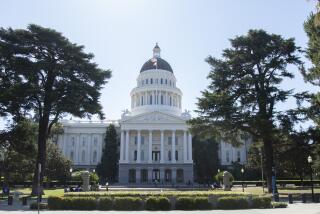Restoration Returns Glory to State Capitol
- Share via
SACRAMENTO — Californians have paid for the most extensive restoration ever undertaken in this country. To see how $67.5 million of taxes was spent, take a tour of the historic state capitol.
Restored to its turn-of-the-century glory in 1982, California’s most important public building is also one of the grandest structures in the state. It’s hard to believe that only a few years ago signs warned visitors to enter at their own risk.
After a century of use the capitol had deteriorated so badly that experts feared it would collapse in an earthquake. But instead of replacing the relic with a new structure, the legislature voted to restore it to its original elegance.
Inside you’ll see the results of six years of painstaking work that was celebrated five years ago when the legislators held their first session in the restored building.
Cleaning 600,000 Bits
One of the tasks was like a giant jigsaw puzzle: removing 600,000 tiny pieces of marble for cleaning and polishing, then reassembling them as the original 1906 mosaic floor. Another was hand-carving bear heads on ornate newel posts of a stairway.
Four years after California became a state in 1850, legislators authorized the building of a capitol in Sacramento. It took two decades and $2.5 million before the most majestic edifice in the West was finally completed in 1874.
Over the years its lavish Victorian interior was destroyed, or hidden by the addition of offices and periodic remodeling. Ornamental stairways, for example, were replaced by elevators.
In the latest renovation, after the completion of hidden structural reinforcements to meet today’s earthquake standards, artisans restored public areas in all their 19th-Century detail.
For instance, there are ceilings that seem to be decorated with frosting, created by squeezing plaster through a pastry tube.
Rooms Mini-Museums
Especially fascinating are seven rooms on the first floor, now returned to their turn-of-the-century appearance as offices of the governor, attorney general, secretary of state and state treasurer. Only the former occupants are missing, as if they momentarily stepped out for lunch.
The rooms are mini-museums that recall how California was run in earlier times. A decorated safe in the treasurer’s office held all of the state’s monies in 1906--about $7 million, mostly in $20 gold pieces. Two other vintage rooms display historic documents from the state archives and old periodicals from the state library.
From the first floor you’ll stretch your neck to see a focal point of the capitol 120 feet overhead--the rotunda dome, exquisitely decorated with gilded scrollwork. At eye level is a century-old marble statue that depicts “Columbus’ Last Appeal to Queen Isabella.”
Look down to the floor designs called the Eureka Tiles that feature symbols in the State Seal, including a grizzly bear and Minerva, the Goddess of Wisdom. Climb the restored ornamental stairway of carved mahogany to the second floor and its 600,000-piece marble mosaic.
Legislative Chambers
On the level above are the impressive legislative chambers of California’s 40-member Senate and 80-member Assembly. Beneath bronze and crystal chandeliers the legislators work at black walnut desks that date to 1869.
The Senate chamber has a red decor and is dominated by a portrait of George Washington, while the Assembly room has a green theme and features a painting of Abraham Lincoln. The senators still make voice votes, but an electronic voting system has been installed for the assemblymen.
Visitors can view the chambers from the upstairs galleries anytime. When the legislature is in session, you must first pass through a metal detector. Usually the sessions are Monday through Thursday (nine months of the year).
Group Tour or Self-Guided
Visitors are welcome to explore the capitol without charge every day of the week (except Christmas and New Year’s Day).
One option is to pick up the California State Capitol self-guided tour brochure and use its map for a look around the five-story building. Visit from 9 a.m. to 5 p.m. weekdays, 10 a.m.-5 p.m. weekends.
Or you can join a free 50- to 60-minute guided tour that starts on the hour (last tour 4 p.m.). Head from the first-floor entrance via elevator or stairs to the basement and Room B-27, where you’ll get a free ticket for a specific tour time.
On the same level is a museum exhibit room that shows the restoration techniques used, and a theater where a 12-minute orientation film is shown.
Another room on the basement floor is a shop with state-related books and gifts. The Capitol cafeteria also is open daily; kids will like the make-your-own ice cream sundaes.
Visitors also are invited to the offices of your own district’s legislators in the East Annex (closed weekends).
If you have time, follow another self-guiding brochure that outlines a Capitol Park tree tour of the 40-acre grounds that surround the imposing copper-domed building. (Guided tours of the grounds are offered in spring and summer.)
Call the State Capitol Museum for additional tour information, (916) 324-0333.
You’ll see the California State Capitol, topped by a golden ball, long before reaching its main entrance off 10th Street between L and N streets. Going north on Interstate 5, exit on Q Street to 5th Street, then go left to Capitol Mall and turn right.
Round trip via Interstate 5 from Los Angeles for a capital time in the capitol at Sacramento is 773 miles.
More to Read
Sign up for Essential California
The most important California stories and recommendations in your inbox every morning.
You may occasionally receive promotional content from the Los Angeles Times.













